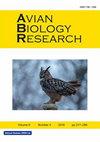潘诺尼亚平原南部(塞尔维亚、伏伊伏丁那)长耳猫头鹰的冬季饮食
IF 1.2
4区 农林科学
Q4 AGRICULTURE, DAIRY & ANIMAL SCIENCE
引用次数: 0
摘要
猫头鹰的饮食在其分布区域的不同区域发生质变。在2014-15年至2017-18年的四个冬季,在塞尔维亚伏伊伏丁那省潘诺尼亚平原南部的三个冬栖地收集了长耳猫头鹰的颗粒。在8070个猎物中,我们鉴定出16种哺乳动物和32种鸟类。以普通田鼠为优势猎物,占比27.4% ~ 71.6%。Muridae家族在整个冬天都是饮食的补充部分:Mus sp.,木鼠和收获鼠。2014 - 2015年冬季,鸟类也是主要的补充猎物,占10.6%。将结果与在斯洛伐克西南部潘诺尼亚平原北部越冬的长耳猫头鹰的饮食进行比较,发现南部部分物种的比例有所增加。本文讨论了不同的农业土地利用和环境条件如何反映在食物供应中,并与长耳猫头鹰的饮食组成有关,一个更丰富的环境既可以增加这些猫头鹰的饮食多样性,也可以扩大其食物生态位。我们的研究将长耳猫头鹰描述为机会主义捕食者,在多样化的猎物面前扩大他们的食物生态位。本文章由计算机程序翻译,如有差异,请以英文原文为准。
Winter diet of Long-eared Owls (Asio otus) in the southern Pannonian Plain (Serbia, Vojvodina)
Owl diets undergo qualitative changes across the different regions of their area of distribution. During the four winters (from 2014–15 to 2017–18), Long-eared Owls’ pellets were collected at three winterroosts located at the southern part of Pannonian Plain, in the Serbian province of Vojvodina. In 8070 prey items from pellets, we identified 16 mammal and 32 bird species. The Common Vole was the dominant prey species with a proportion in a range from 27.4% to 71.6%. The Muridae family formed a supplementary part of the diet: Mus sp., wood mouse and harvest mouse, during all winters. Birds were also a major supplementary prey during winter 2014–15, comprising 10.6%. A comparison of our results with the diet of Long-eared Owls wintering at the northern Pannonian plain (southwestern Slovakia) indicated an increase the proportion of some species in the southern part. How different land uses in agriculture and environmental conditions may be reflected in the food supply are discussed in relation to the diet composition of Long-eared Owls and an environment whose is richer provides both growing diversity in the diet of these owls and an expansion of their food niche. Our study described the Long-eared Owl as opportunistic predators expanding their food niche in the presence of diversified prey.
求助全文
通过发布文献求助,成功后即可免费获取论文全文。
去求助
来源期刊

Avian Biology Research
农林科学-奶制品与动物科学
CiteScore
1.50
自引率
0.00%
发文量
17
审稿时长
2 months
期刊介绍:
Avian Biology Research provides a forum for the publication of research in every field of ornithology. It covers all aspects of pure and applied ornithology for wild or captive species as well as research that does not readily fit within the publication objectives of other ornithological journals. By considering a wide range of research fields for publication, Avian Biology Research provides a forum for people working in every field of ornithology.
 求助内容:
求助内容: 应助结果提醒方式:
应助结果提醒方式:


